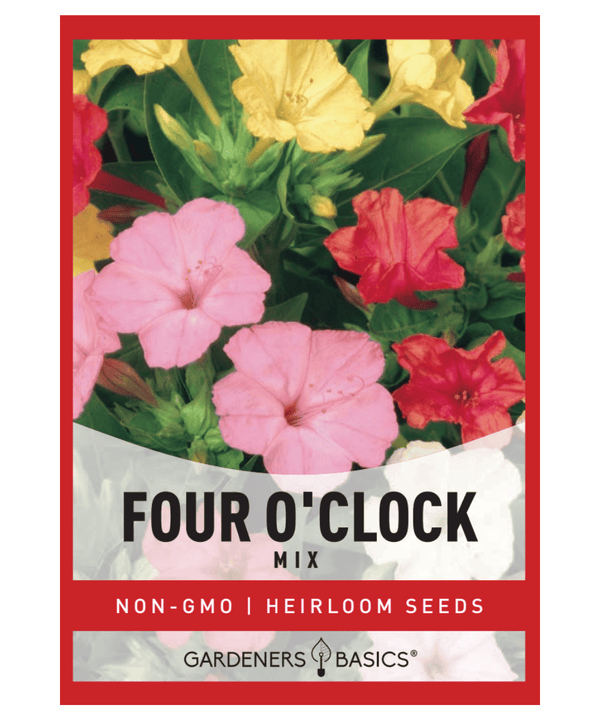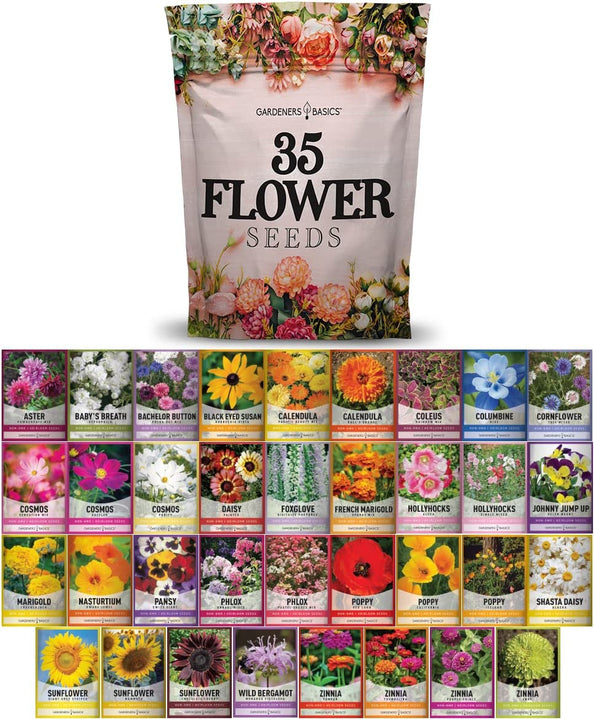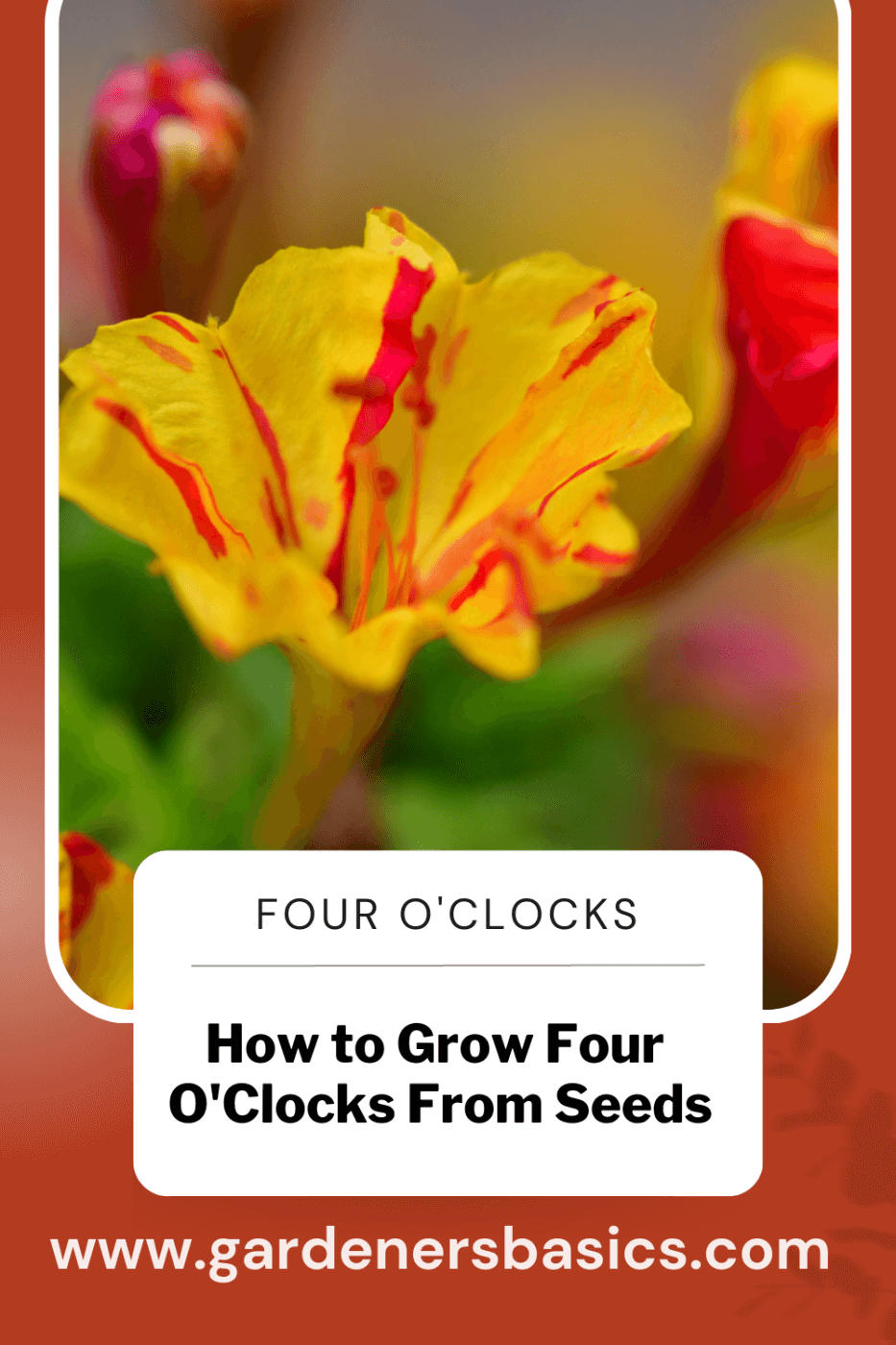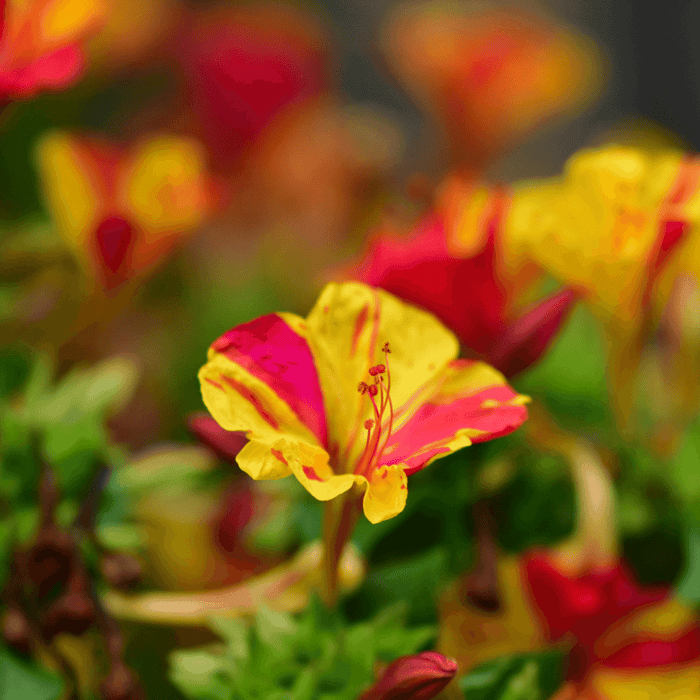Four o'clock plants, scientifically known as Mirabilis jalapa, are versatile and easy-to-grow flowering plants. Native to the tropical regions of South America, these plants have trumpet-shaped flowers in various colors, including white, pink, yellow, and even multi-colored patterns. The blooms open late afternoon or early evening, hence the name "four o'clock." They remain open throughout the night, releasing a pleasant fragrance that attracts pollinators like hummingbirds and moths. This comprehensive step-by-step guide will give you all the information you need to successfully learn how to grow four o clocks from seed. Follow these guidelines and watch your garden come alive with vibrant, fragrant flowers.
Table of Contents
- Plant Characteristics
- Selecting and Purchasing Seeds
- Preparing the Soil
- When to Plant
- How to Plant Four O'Clock Seeds
- Caring for Four O'Clock Plants
- Pest and Disease Management
- Harvesting and Enjoying Your Four O'Clock Flowers
- Soil Amendments for Four O'Clock Plants
- Companion Planting with Four O'Clocks
- Propagation Methods for Four O'Clock Plants
- Overwintering Four O'Clock Plants
- Frequently Asked Questions
Plant Characteristics
- Native: Tropical regions of South America
- Family: Nyctaginaceae
- Genus: Mirabilis
- Common Name: Four o'clock, Marvel of Peru
- History of the Seed: Brought to Europe in the 16th century and widely cultivated since then
- Days till Maturity: 50-60 days from sowing
- Planting Depth: 1/4 inch
- Plant Spacing: 18-24 inches apart
- Days to Germination: 7-14 days
- Indoors or Direct Sown: Both options are possible
- Full Sun or Partial Shade: Full sun to partial shade
- When to Harvest: Mid-summer to fall
- Plant Height: 24-48 inches tall
- Plant Width: 18-36 inches wide
Selecting and Purchasing Seeds
To begin, you must purchase high-quality four o'clock flower seeds for planting. Choosing seeds from a reputable seed store like Gardeners Basics is essential to ensure healthy, vibrant plants. When selecting your seeds, look for varieties with the desired colors, including white, pink, yellow, or multi-colored patterns. Remember that the flowers will bloom in the late afternoon or early evening, so choose colors that complement your garden's overall aesthetic.
Four O’Clock Formula Mix Seeds

$2.49
Formula Mix Four O’Clock Seeds – Heirloom, Non-GMO, Non-Hybrid, Open-Pollinated Garden Favorites Discover the vibrant beauty of Formula Mix Four O’Clock flowers, a stunning heirloom flower variety known for its bright, trumpet-shaped blooms that open in the late afternoon and… read more
Preparing the Soil
Four o'clock plants thrive in well-drained soil that is rich in organic matter. Before planting, prepare the soil by adding compost or aged manure to improve its structure, drainage, and nutrient content.
- Choose a planting location that receives full sun to partial shade. Four o'clock plants will grow in various light conditions but produce the most abundant blooms in full sun.
- Remove any weeds, rocks, and debris from the planting area, then loosen the soil to a depth of 12-18 inches using a garden fork or tiller.
- Mix in a 2- to 4-inch layer of compost or aged manure to improve soil fertility and drainage. This will also help create a favorable environment for your four o'clock plants to thrive.
- Add soil amendments, such as peat moss, perlite, or vermiculite, to further enhance the soil's structure and fertility. You can also incorporate bone meal for an extra phosphorus boost, which promotes strong root growth and flower production.
When to Plant
Timing is crucial when planting four o'clock seeds. Ideally, you should sow the seeds outdoors when the danger of frost has passed, typically in mid-spring to early summer. In cooler climates, you can start the seeds indoors 4-6 weeks before the last expected frost date to give the plants a head start.
How to Plant Four O'Clock Seeds
Whether planting indoors or directly sowing in the garden, planting four o'clock seeds is relatively straightforward.
Indoor Planting:
- Fill seed trays or small pots with a high-quality seed-starting mix.
- Sow the seeds at a depth of 1/4 inch and lightly cover them with the seed-starting mix.
- Water the seeds gently to moisten the soil without disturbing the seeds.
- Place the seed trays or pots in a warm, well-lit location with a temperature of 65-75°F (18-24°C).
- Keep the soil consistently moist but not waterlogged. Germination should occur within 7-14 days.
- Once the seedlings have at least two sets of true leaves and all danger of frost has passed, transplant them outdoors, spacing them 18-24 inches apart.
Direct Sowing:
- Mark out the planting area in your prepared garden bed.
- Sow the seeds 1/4 inch deep and 18-24 inches apart in rows or clusters.
- Water the seeds gently to settle the soil around them.
- Keep the soil moist until germination occurs, typically within 7-14 days.
Caring for Four O'Clock Plants
After planting, four o'clock plants require minimal maintenance to thrive. Follow these guidelines to keep your plants healthy and encourage abundant blooms:
- Watering: Keep the soil evenly moist, especially during dry periods. Avoid overwatering, as this can lead to root rot.
- Fertilizing: Apply a balanced, slow-release fertilizer mid-summer to promote vigorous growth and flower production. Follow the package instructions for the correct application rate.
- Mulching: Add a 2- to 3-inch layer of organic mulch around the base of the plants to conserve moisture, suppress weeds, and regulate soil temperature.
- Deadheading: Regularly remove spent flowers to encourage continuous blooming throughout the season.
Pest and Disease Management
Four o'clock plants are pest-resistant but may occasionally be affected by aphids or spider mites. Monitor your plants for signs of infestation, and treat any issues promptly using insecticidal soap or other appropriate methods.
Diseases like powdery mildew and leaf spot can also affect four o'clock plants. Ensure proper spacing to promote good air circulation and minimize disease risk. If symptoms appear, remove any affected plant material and treat it with a fungicide.
Harvesting and Enjoying Your Four O'Clock Flowers
As your four o'clock plants bloom from mid-summer to fall, you can harvest the flowers to create colorful, fragrant arrangements for your home. Follow these steps for successful flower harvesting:
- Choose fully or nearly open blooms, as they will not continue to open once cut.
- Cut the flowers in the early morning or late afternoon when they are most hydrated and fragrant.
- Use clean, sharp scissors or pruning shears to cut the stems at an angle to maximize water uptake.
- Immediately place the cut stems in a container of lukewarm water to prevent air bubbles from forming in the stems, which can inhibit water uptake.
In addition to enjoying the flowers in your garden or as cut arrangements, four o'clock plants can also be grown in containers on patios or balconies. This lets you appreciate their beauty and fragrance up close, even with limited garden space.
Four o'clock plants will self-seed and spread in the garden, so new seedlings may pop up in unexpected places. If you prefer a more controlled spread, collect the seeds in late fall when the seed pods have turned brown and brittle. Store the seeds in a cool, dry place until you're ready to sow them again the following spring.
Soil Amendments for Four O'Clock Plants
Although four o'clock plants can tolerate a range of soil types, they will perform best in fertile, well-draining soil. Here are some additional soil amendments to consider:
- Peat moss: This organic material improves soil structure, retains moisture, and provides nutrients. Incorporate a 2- to 3-inch layer of peat moss into the planting area to create a more favorable environment for four o'clock plants.
- Perlite or vermiculite: Adding perlite or vermiculite can improve drainage and aeration, preventing root rot and encouraging healthy root development. Mix in a 1- to 2-inch layer of either material when preparing the planting area.
- Bone meal: This slow-release phosphorus source promotes strong root growth and flower production. Add bone meal according to the package instructions before planting your four o'clock seeds.
Wildflower, Perennial, & Annual Flower Seed Kit | 35 Variety Pack

$29.95
$49.95
35 Flower Seeds Variety Pack – Heirloom, Non-Hybrid, Non-GMO, Open-Pollinated – Perfect for Pollinator-Friendly Gardens Transform your garden with our 35 Flower Seeds Variety Pack, offering a stunning and diverse selection of heirloom, non-hybrid, and non-GMO seeds. Each variety in… read more
Companion Planting with Four O'Clocks
Four o'clock plants can benefit from companion planting, which involves growing specific plants together for mutual benefits such as pest control, pollination, and improved growth. Here are some suitable companion plants for four o'clock:
- Marigolds: Marigold flowers deter many common garden pests and can help protect your four o'clock plants from infestation.
- Sunflowers: Tall sunflowers for planting provide shade for four o'clock plants in hot climates, reducing the risk of heat stress.
- Lavender: The strong fragrance of lavender plants can help mask the scent of four o'clock plants, making it more difficult for pests to locate them.
- Mint: Planting mint plants nearby can help repel aphids, a common pest of four o'clock plants. However, mint can be invasive, so consider planting it in a container to control its spread.
Propagation Methods for Four O'Clock Plants
While growing four o'clock plants from seed is the most common method, they can also be propagated by other means:
- Division: Mature four o'clock plants can be divided in early spring or fall. Dig up the tuberous root, cut it into sections with at least one eye or growth point per section, and replant the divisions 18-24 inches apart.
- Cuttings: Take 4- to 6-inch stem cuttings from healthy four-o'clock plants in late summer. Remove the lower leaves and dip the cut end in the rooting hormone. Plant the cuttings in a well-draining potting mix and keep them moist until roots develop. Transplant the rooted cuttings outdoors in spring.
Overwintering Four O'Clock Plants
In warmer climates (USDA hardiness zones 7-11), four o'clock plants can be grown as perennials. In colder regions, the tuberous roots can be dug up and stored over winter to be replanted the following spring:
- After the first frost, carefully dig up the tuberous roots, not damaging them.
- Gently remove soil from the roots and allow them to air-dry for a day or two.
- Store the roots in a cool, dry, dark location like a basement or garage. Place them in a box or container filled with peat moss, sand, or sawdust to prevent them from drying out.
- Replant the roots outdoors in spring after the danger of frost has passed.
Incorporating these additional tips and techniques into your four o'clock growing routine can be an even more successful and rewarding gardening experience. From soil amendments and companion planting to alternative propagation methods and overwintering, these extra steps will help you cultivate thriving, beautiful four-o'clock plants in your garden.
 Frequently Asked Questions - How to Grow Four O'Clocks From Seed
Frequently Asked Questions - How to Grow Four O'Clocks From Seed
Q: What colors do four o'clock flowers come in?
A: Four o'clock flowers come in various colors, including white, pink, yellow, and even multi-colored patterns.
Q: When do four o'clock flowers bloom?
A: Four o'clock flowers typically bloom in the late afternoon or early evening and remain open throughout the night. They bloom from mid-summer to fall.
Q: Can four o'clock plants grow in partial shade?
A: Yes, four o'clock plants can grow in both full sun and partial shade. They will produce the most abundant blooms in full sun.
Q: How tall do four o'clock plants grow?
A: Four o'clock plants can grow to a height of 24-48 inches tall and have a width of 18-36 inches.
Q: How long does it take for four o'clock seeds to germinate?
A: Four o'clock seeds typically take 7-14 days to germinate.
Q: Can I grow four o'clock plants in containers?
A: Yes, four o'clock plants can be grown in containers on patios or balconies, allowing you to enjoy their beauty and fragrance even with limited garden space.
Q: Are four o'clock plants annuals or perennials?
A: In warmer climates (USDA hardiness zones 7-11), four o'clock plants can be grown as perennials. They are typically grown annually in colder regions, but the tuberous roots can be dug up, stored over winter, and replanted the following spring.
Q: What pests and diseases affect four o'clock plants?
A: Four o'clock plants can be affected by aphids, spider mites, powdery mildew, and leaf spot. To minimize the disease risk, ensure proper spacing to promote good air circulation and monitor plants for signs of infestation.







